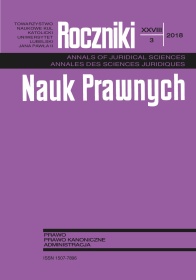The Concept of Relics And Canonical Recognition, Transfer and Preservation of the Mortal Remains of Servantof God According to the Instruction of the Congregation for the Causes of Saints on December 8, 2017
Abstract
For the first time since the reform of canon law in 1983 the terminology regarding relics was put in the official document of the Holy See. The Instruction distinguishes between significant and non-significant relics. Referring to the decrees of the Sacred Congregation of Rites, it shows the reasons why this particular division was rightly introduced. The Bishop of the diocese or of the eparchy where mortal remains are preserved is competent to perform all the possible procedures on them, provided he has obtained beforehand the consent of the heirs and the consent of the Congregation for the Causes of Saints (different variants are possible). Apart from a Tribunal the Bishop nominates expert pathologists, people charged with performing the technical aspects of the works and two witnesses. The procedures of canonical recognition of the remains, the extraction of some fragments in case of imminent beatification and some final operations are discussed.
References
Bartoszewski Gabriel: Ekshumacja i kanoniczne rozpoznanie doczesnych szczątek sługi Bożego w świetle Instrukcji Kongregacji Spraw Kanonizacyjnych „Sanctorum Mater”, [w:] O Sanctorum Mater, red. W. Bar, L. Fiejdasz, Lublin: Stowarzyszenie Kanonistów Polskich 2008, s. 99-118.
Bartoszewski Gabriel: Ekshumacja i zabezpieczenie doczesnych szczątków sług Bożych, [w:] Świętość Kanonizowana, t. 11: Kult relikwii, red. Sz.T. Praśkiewicz, Kraków: Wydawnictwo Karmelitów Bosych 2013, s. 39-59.
Criscuolo Vincenzo: Praenotatio Relatoris Generalis, [w:] Congregatio de Causis Sanctorum, Peorien. Beatificationis et Canonizationis Servi Dei Fulton Ioannis Sheen Archiepiscopi Titularis Neoportensis Episcopi Roffensis in America (1895-1979), Positio super vita, virtutibus et fama sanctitatis, vol. I, Roma: Tipografiia Nova Res s.r.l. 2011, s. I-VI.
Darmorost Elżbieta: Ustawa o cmentarzach i chowaniu zmarłych. Komentarz, Warszawa 2014, LEX/el.
Fiejdasz Lidia: Kształtowanie się pojęcia relikwii: aspekt prawny, [w:] Świętość Kanonizowana, t. 11: Kult relikwii, red. Sz.T. Praśkiewicz, Kraków: Wydawnictwo Karmelitów Bosych 2013, s. 17-38.
La santitá nel mondo di oggi. Presentata l’esortazione apostolica «Gaudete et exsultate», L’Osservatore Romano ed. Quottidiana Anno CLVIII n. 81 (47.814), lunedi-martedi 9-10 aprile 2018, s. 1.
Misztal Henryk, Fiejdasz-Buczek Lidia: Postępowanie kanonizacyjne w diecezji lub eparchii, Lublin: Wydawnictwo KUL 2017.
Misztal Henryk: Prawo kanonizacyjne. Instytucje prawa materialnego, zarys historii, procedura, wyd. 2, Lublin: Wydział Prawa, Prawa Kanonicznego i Administracji KUL, Sandomierz: Wydawnictwo Diecezjalne 2003.
Palazzini Pietro: Le congregazione romane, [w:] La Curia Romana nella Cost. Ap. «Pastor Bonus» a cura di P.A. Bonnet, C. Gullo, Città del Vaticano: LEV 1990, s. 309-329.
Partyk Aleksandra: Pierwszeństwo osób wymienionych w art. 10 ust. 1 ustawy o cmentarzach i chowaniu zmarłych, do pochówku zwłok w określonym grobie oraz do ekshumacji, LEX/el. 2014.
Scąber Andrzej: Rozpoznanie i zabezpieczenie doczesnych szczątków sług Bożych oraz pobranie relikwii w procedurze beatyfikacyjnej – instrukcje Kongregacji Spraw Kanonizacyjnych i procedura, [w:] Świętość Kanonizowana, t. 11: Kult relikwii, red. Sz.T. Praśkiewicz, Kraków: Wydawnictwo Karmelitów Bosych 2013, s. 72-91.
Copyright (c) 2018 Roczniki Nauk Prawnych

This work is licensed under a Creative Commons Attribution-NonCommercial-NoDerivatives 4.0 International License.


